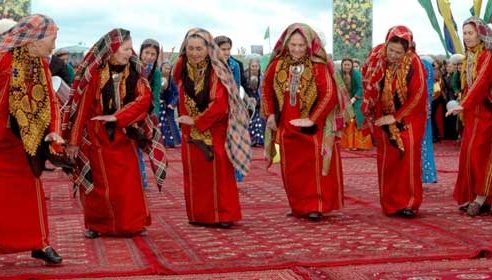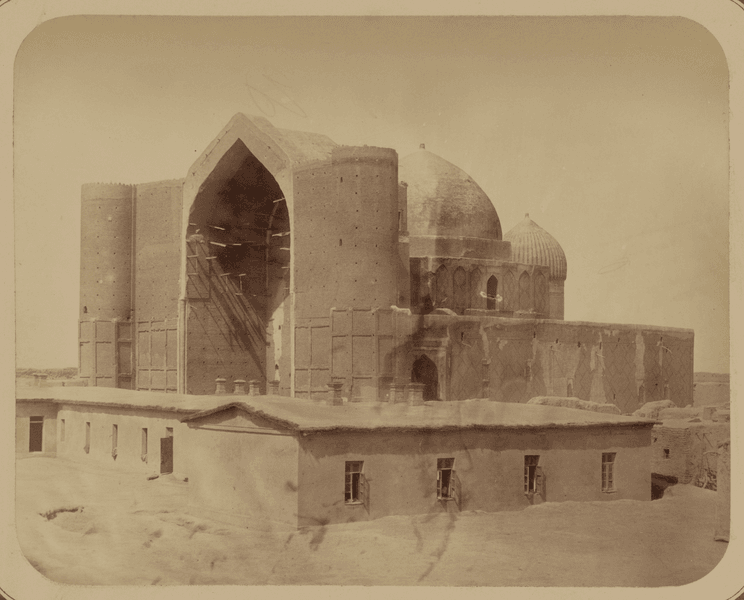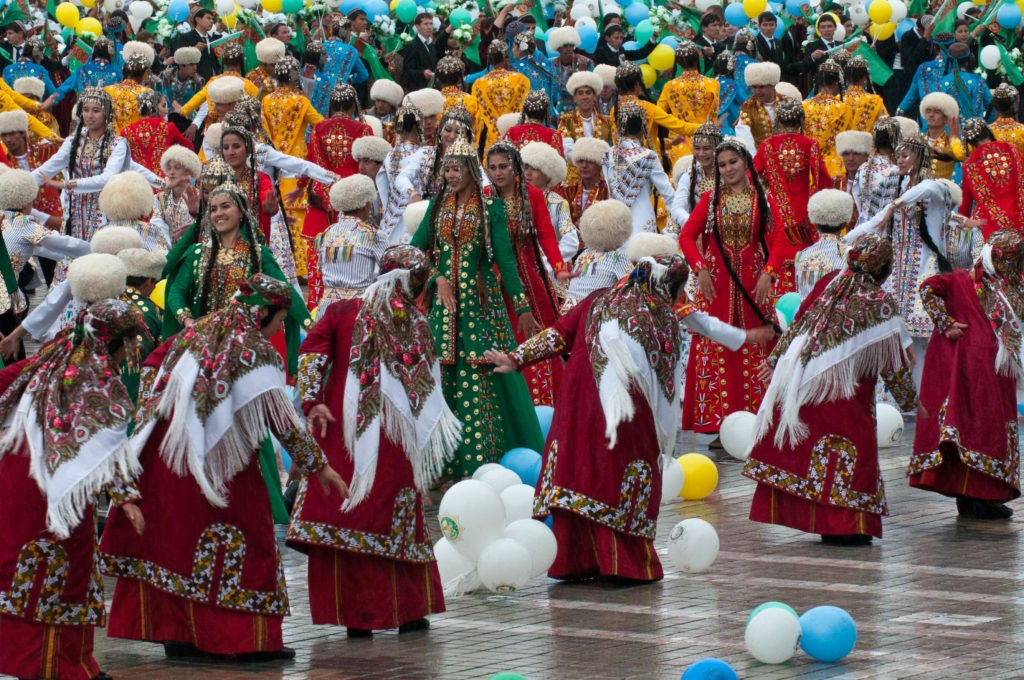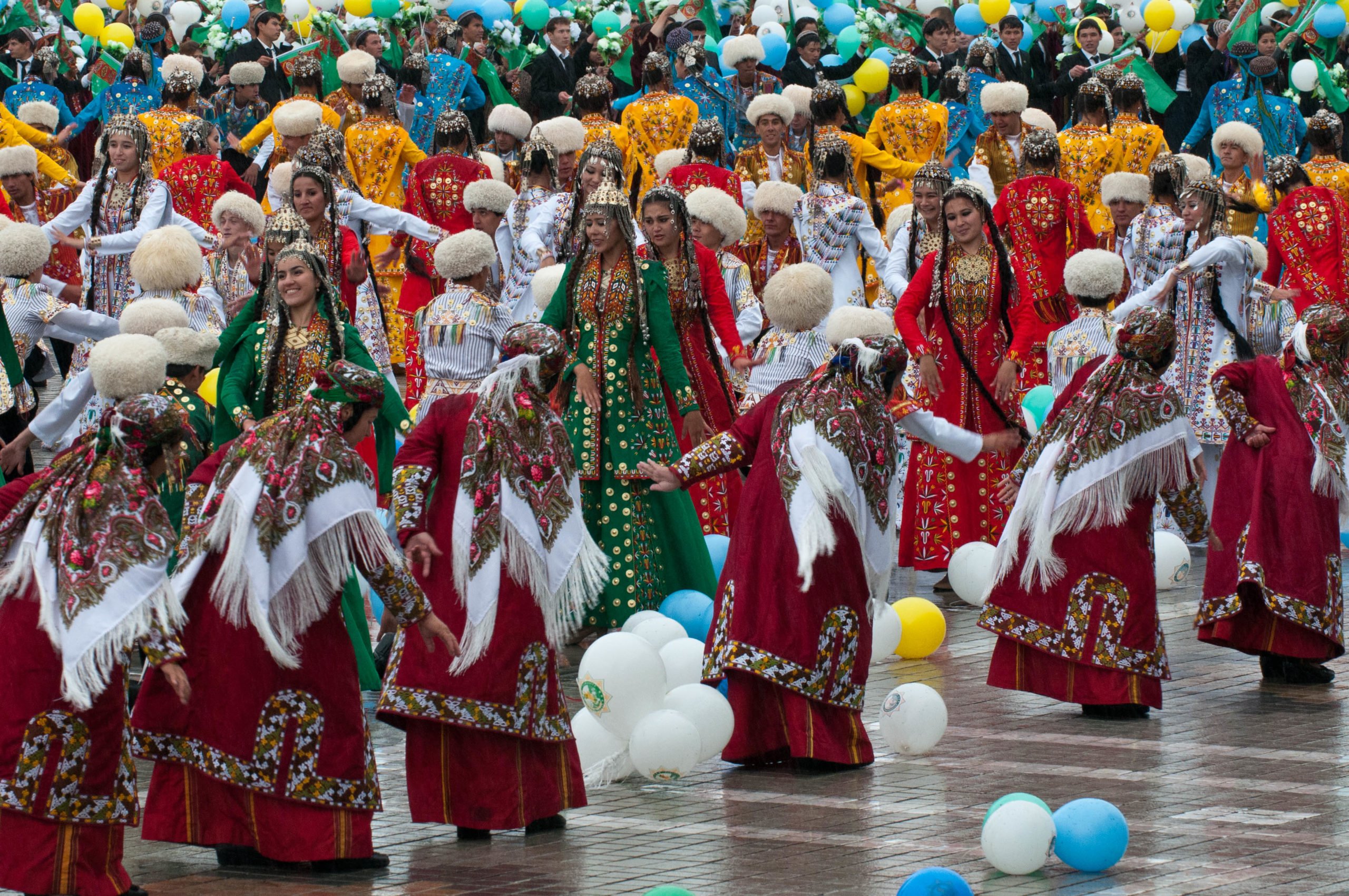
I heard singing with the distinct “hu hu” breathing pattern, and instantly, a small circle of people gently formed in the middle of the crowd in the courtyard of the groom’s house. The people in the circle—children and adults—danced around the circle stamping their right foot on the ground, and afterwards, jumping up and throwing both arms in the air. There was no boundary between the spectators of the dance and its participators: people seamlessly moved in and out of the circle. The energy created by the stamps, the claps and the singing was astonishing. These are my memories of the Turkmen dance kushtdepdi.
Kushtdepdi is a Turkmen folk dance practiced at weddings by the members of the celebrating community and is accompanied by special songs called ghazal or kushtdepme. To understand the various ways in which kushtdepdi is practiced by the Turkmen we must distinguish between the concepts of ‘a dance in the field’ and ‘ethno identity dance’, codified by Anthony Shay—a scholar specializing in dances from Eastern Europe, the Middle East, North Africa, and Central Asia. According to Shay, the term ‘dance in the field’ represents dances that form an organic part of local communal life while the term ‘ethno identity dance’ refers to dances that are choreographed or prepared for the stage.
The origins of kushtdepdi in the field are ambiguous. There is strong evidence to suggest that until the 1970s, the dance was practiced widely by the Yomut Turkmen on the eastern coast of the Caspian Sea. We also know that in the following years, the dance spread in Turkmenistan both as a communal celebratory dance and as a staged dance.[1] In terms of the origins of the dance, the most prominent narrative is advanced by Turkmen scholars. This narrative suggests that the dance comes from dhikr healing ritual associated with the Sufi mystical Islam. The uniformity of the discussions by these scholars creates an impression that the dance is an ‘invented tradition’.[2] This in its turn rouses suspicion that their hypothesis might in fact be a product of post-Soviet nation-building efforts. In order to assess the validity of this hypothesis, the aim of the rest of this article is to compare the elements of the Sufi rite of affliction practiced among the Turkmen and kushtdepdi in the field. What we find in the end is the great likelihood of the origins of kushtdepdi to lie in a Sufi healing ritual.
Turkmen folklorists claim that kushtdepdi comes from a healing rite. For example, Geldiyev writes that kushtdepdi emerges on the basis of dhikr. Gochmuradov takes it even further to state, that indeed, dhikr itself is a form of folk art.[3] Additionally, Otdiyev and Atdayeva explain that kushtdepdi comes from porhanchylyk, i.e.shamanic practices.[4] Dhikr is ‘originally a Qur’anic word, commanding “remembrance of God”, and an act of devotion during and after prayer’. [5] Here, it is important to note that while dhikr is strictly an Islamic notion, neither of the aforementioned scholars attribute dhikr to Sufism, and in fact, some assign kushtdepdi to be an extension of shamanism. Devin Deweese explains that mislabeling Sufi elements as shamanistic was a common practice by Soviet academics as a result of the government’s hostility towards Sufis and their institutions—potential sources of opposition.[6] This makes it clear why the Turkmen scholars, who follow the trajectory set by Soviet academics, never explicitly pinpoint Sufism when referring to dhikr and for this inquiry we must consider dhikr in the context of Sufism.
While the Turkmen scholars offer a hypothesis on the origin of kushtdepdi, their discussions seem speculative as they lack any nuanced explanation of the transformation of a religious ritual into a codified dance. Yet, it is crucial to recognize that such analysis is difficult to accomplish, because there is ‘no documented history of dance prior to the early twentieth century’ on the territory of present-day Turkmenistan.[7]Due to this limitation, the only viable method of assessing the hypothesis lies in analyzing the transformation of the Sufi rite of affliction into kushtdepdi by comparing the two.
One of the most profound points of comparison of the Sufi healing ritual and kushtdepdi is their vocal and physical movement components. Devin Deweese analyzes two ethnographic studies of the Turkmen which provide a primary source basis for the comparison: a study of a healing ritual by Iomud Khan published in 1924 and a study of a wedding dance by Annaklychev published in 1960.
A vocal element discernible both in the Sufi rite and kushtdepdi is the vocal inhaling and exhaling. Deweese illustrates the vocal element of a healing ritual described by Iomud Khan: ‘the ishan begns to utter “hu, hu“, and the people sitting around the tent join in; if they slacken their cries, the ishan says “hu” again, and after awhile [sic] he says “Alla” and the people cease shouting and rest’.[8] Similarly, the phrase “hu, hu“[9] was part of a wedding dance described by Annaklychev in 1960 and it is part of kushtdepdi to this day. In fact, all of the kushtdepdi techniques which I witnessed in person or on video materials involve the vocal inhaling and exhaling.
The nature of Sufism in Central Asia explains the vocal correlation between the healing ritual and kushtdepdi. The most prevalent Sufi order among the Turkic-speaking nomads was the Yasavi order, founded by Ahmad Yasavi. A distinguishing feature of the Yasavi order is the jahariya dhikr, or dhikr ‘practiced aloud’. [10] Spencer J. Trimingham explains that Ahmad Yasavi ‘is said to have introduced the “rasping saw” dhikr, a tradition which no doubt attests to its Central Asian origin. For this the ha is expired very deeply, then hi aspired as low as possible; and it sounds much like sawing’.[11] Both of the aforementioned ethnographic works refer to this ‘rasping saw’ sounds. Indeed, jahariya dhikr ‘came to be adopted as a part of Turkmen healing rituals in communities in which saints of the Yasavi tradition were quite prominent’ [12] and ‘as an entertaining genre for wedding and house-warming ceremonies’.[13] While the verses of kushtdepmeler adopt poetry of prominent Central Asian Sufis, such as Alisher Navoyi, and repeatedly refer to the name of Sufi figures, such as Ahmad Yasavi and Baha’ ad-Din Naqshbandi,[14] it is the ‘rasping saw’ sounds present in both the Sufi ritual of affliction and kushtdepdi that make their correlation irrefutable.

Comparison of the physical movements of the healing rite and the dance also unearths their correlation. According to the analysis of Iomud Khan’s description of the healing ritual, ‘the sick person is always seated in the center of the tent, with the other people sitting in a circle around him’[15] and after the ‘rasping saw’ chanting ‘at first they bow as they go, and then they begin to stamp their feet on the floor and jump in time to the singing’.[16] Annaklychev’s observations of the wedding dance are similar in that ‘several people form a circle; one of them begins singing the “ghazal“, while the others begin the dance, stamping their feet and jumping in time to the song.”[17] Kushtdepdi today is similarly practiced in a circle while feet stamping, bending at the waist and jumping are all fundamental choreographic elements of the dance. The common movements practiced by people during the rite of affliction and the dance point to the connection between the two. Iomud Khan’s observation that dhikr which began to be practiced for entertainment only further underscores this connection.[18] Furthermore, the oral history in the Turkmen community, especially among the Yomut, confirms that kushtdepdi was once a healing ritual.[19]
With the correlation between the Sufi rite of affliction and kushtdepdi established, the question remains: why did the ritual transform into a codified dance? One possible answer is that the younger members of the community began imitating the shamans for their entertainment.[20] Another explanation—perhaps a historically sound one—lies in the hostility of the Soviet government towards ‘unofficial’ Islam, which included ‘ancestral worship, shrine veneration, pilgrimage to shrines, popular healing, prayer at unofficial mosques, performance of dhikr [emphasis added]’.[21] Deweese confirms that in Central Asia ‘the face of religious life indeed changed dramatically’ in the 1930s and 40s.[22] Geldiyev adds, that with the coming of the Soviets, the religious schools were closed and the shamanic activities were terminated, and as a result, kushtdepdi emerged.[23]

Whether the dance originated as a result of religious censorship or imitation for entertainment, the correlation between the Sufi healing ritual and kushtdepdi, on the basis of shared vocal elements and physical movements, is convincing. Understanding the origins of kushtdepdi is important not only because the dance is understudied, but also because it helps to unravel its transformation from a dance in the field into and ethno-identity dance. This in its turn provides a look into the present socio-political life of the Turkmen.
Bibliography
Annamuradov, R. Küštdepdi. Ashgabat, 2007.
DeWeese D. “Shamanization in Central Asia.” Journal of the Economic and Social History of the Orient 57, no. 3 (2014): 326–63.
Geldiyev, G. “Küštdepmeler.” In Türkmen Šahyrana Halk Döredijiligi, 257–65. Ashgabat: Türkmen Döwlet Neširÿat gullugy, 2003.
Gochmuradov, H. “Küštdepdiler.” In Türkmen Halk Döredijiligi, 59–63. Ashgabat: Türkmen Döwlet Neširÿat gullugy, 2010.
Gross, Jo-Ann. “The Polemic of ‘Official’ and ‘Unofficial’ Islam: Sufism in Soviet Central Asia.” In Islamic Mysticism Contested: Thirteen Centuries of Controversies and Polemics, edited by Frederick De Jong and Bernd Radtke, Vol. 29. Leiden: Brill, n.d.
Hobsbawm, Eric., and Terence. Ranger. The Invention of Tradition. New York: Cambridge University Press, 2012.
Oraztaganov, Allaberdi. Куштдепмелер. Edited by Gozel Amanguliyeva. Ashgabat: Turkmen State Medical University, 1998.
Otdiyev, G, and N Atdayeva. “Küštdepmeler.” In Türkmen Halk Döredijiligi (Turkmen Folk Art), 62–68. Ashgabat: Türkmen Döwlet Neširÿat gullugy, 2010.
Radkina, N. P. “Turkmenistan.” In The International Encyclopedia of Dance. Oxford University Press, 1998.
Shay, Anthony. Ethno Identity Dance for Sex, Fun and Profit: Staging Popular Dances around the World. Palgrave Macmillan, 2016.
Sultanova, Razia. From Shamanism to Sufism: Women, Islam and Culture in Central Asia. International Library of Central Asian Studies; 3. London; I B. Tauris, 2011.
“The World Factbook — Central Intelligence Agency,” accessed October 17, 2018, https://www.cia.gov/library/publications/the-world-factbook/geos/tx.html.
Trimingham, J. Spencer. The Sufi Orders in Islam.
1 online resource (xx, 333 pages) vols. New York: Oxford University Press,
1998.
[1] G. Geldiyev, “Küštdepmeler,” in Türkmen Šahyrana Halk Döredijiligi (Ashgabat: Türkmen Döwlet Neširÿat gullugy, 2003), 257–65.
[2] Eric. Hobsbawm and Terence. Ranger, The Invention of Tradition., (New York: Cambridge University Press, 2012).
[3] H. Gochmuradov, “Küštdepdiler,” in Türkmen Halk Döredijiligi (Ashgabat: Türkmen Döwlet Neširÿat gullugy, 2010), 59.
[4] G. Otdiyev and N. Atdayeva, “Küštdepmeler,” in Türkmen Halk Döredijiligi (Turkmen Folk Art) (Ashgabat: Türkmen Döwlet Neširÿat gullugy, 2010), 62–68.
[5] Razia. Sultanova, From Shamanism to Sufism: Women, Islam and Culture in Central Asia, International Library of Central Asian Studies ; 3 (London ; I B. Tauris, 2011), 137.
[6] DeWeese D., “Shamanization in Central Asia,” Journal of the Economic and Social History of the Orient 57, no. 3 (2014): 326–63.
[7] N. P. Radkina, “Turkmenistan,” in The International Encyclopedia of Dance (Oxford University Press, 1998), http://www.oxfordreference.com/view/10.1093/acref/9780195173697.001.0001/acref-9780195173697-e-1771.
[8] DeWeese, “Shamanization in Central Asia,” 332.
[9] Ibid., 338.
[10] Lindsay Jones, Mircea Eliade, and Charles J. Adams, Encyclopedia of Religion, 2nd ed. (Detroit: Macmillan Reference USA, 2005).
[11] J. Spencer Trimingham, The Sufi Orders in Islam, (New York: Oxford University Press, 1998), 197.
[12] Jo-Ann Gross, “The Polemic of ‘Official’ and ‘Unofficial’ Islam: Sufism in Soviet Central Asia,” in Islamic Mysticism Contested: Thirteen Centuries of Controversies and Polemics, ed. Frederick De Jong and Bernd Radtke, vol. 29 (Leiden: Brill, n.d.), 533.
[13] R. Sultanova, From Shamanism to Sufism: Women, Islam and Culture in Central Asia, 95.
[14] Allaberdi Oraztaganov, Куштдепмелер, ed. Gozel Amanguliyeva (Ashgabat: Turkmen State Medical University, 1998).
[15] DeWeese, “Shamanization in Central Asia,” 332.
[16] Ibid., 333.
[17] Ibid., 338.
[18] Ibid., 333.
[19] R. Annamuradov, Küštdepdi (Ashgabat, 2007).
[20] Otdiyev and Atdayeva, “Küštdepmeler.”
[21] Gross, “The Polemic of ‘Official’ and ‘Unofficial’ Islam: Sufism in Soviet Central Asia,” 525.
[22] DeWeese, “Shamanization in Central Asia,” 339.
[23] Geldiyev, “Küštdepmeler,” 257-58.
